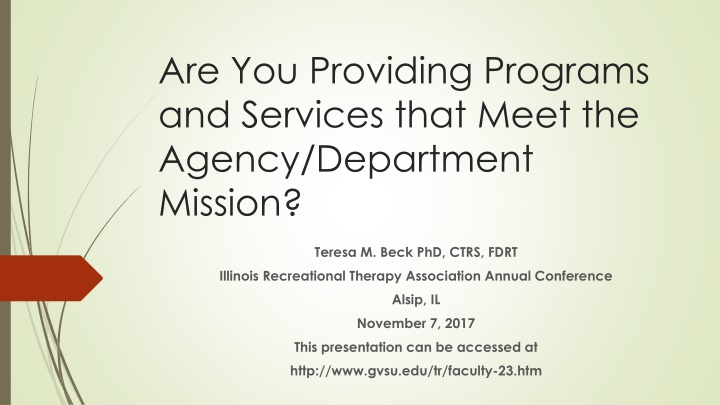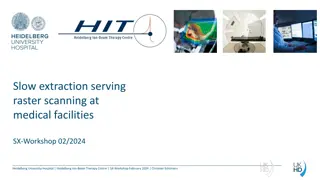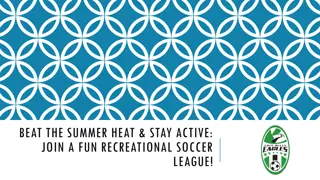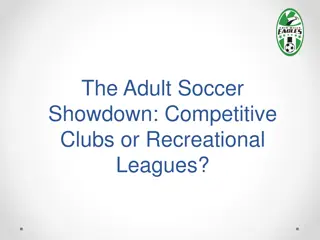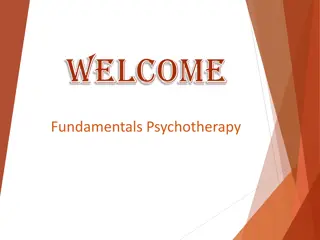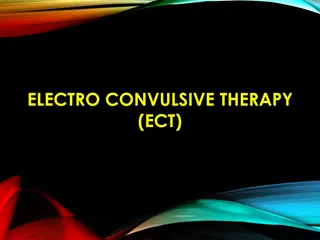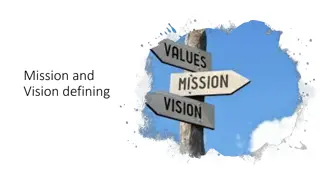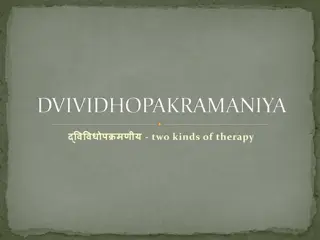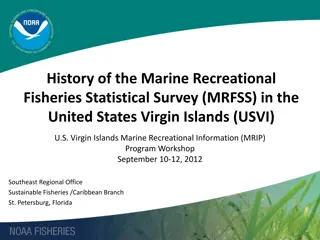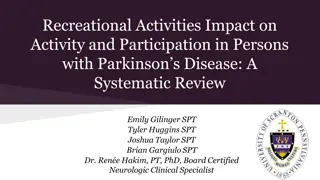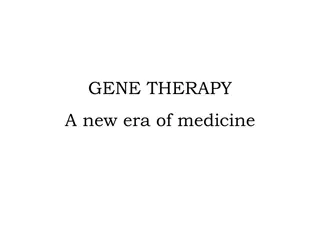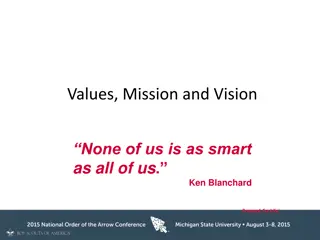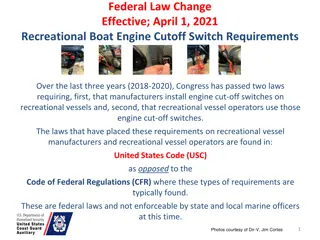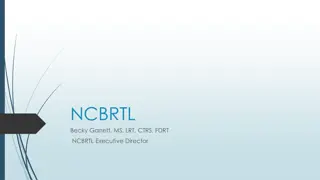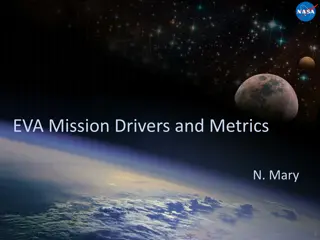Mission and Vision in Recreational Therapy Programs
Explore the importance of mission and vision statements in shaping recreational therapy programs, as discussed in presentations and examples from industry experts. Learn how these fundamental statements guide the direction, values, and client engagement strategies of agencies and programs in the field. Gain insights into evaluating programs effectively to ensure they align with organizational goals and improve client outcomes.
Download Presentation

Please find below an Image/Link to download the presentation.
The content on the website is provided AS IS for your information and personal use only. It may not be sold, licensed, or shared on other websites without obtaining consent from the author.If you encounter any issues during the download, it is possible that the publisher has removed the file from their server.
You are allowed to download the files provided on this website for personal or commercial use, subject to the condition that they are used lawfully. All files are the property of their respective owners.
The content on the website is provided AS IS for your information and personal use only. It may not be sold, licensed, or shared on other websites without obtaining consent from the author.
E N D
Presentation Transcript
Are You Providing Programs and Services that Meet the Agency/Department Mission? Teresa M. Beck PhD, CTRS, FDRT Illinois Recreational Therapy Association Annual Conference Alsip, IL November 7, 2017 This presentation can be accessed at http://www.gvsu.edu/tr/faculty-23.htm
Session Objectives Identify the difference between a mission statement and vision statement Identify three values that drive your agency/program Identify 2 methods of gaining client input in your services Identify 2 strategic directions you would like your agency/program to pursue Identify 1 program evaluation method that best suits your agency/program
Vision Statement identifying where you want your organization or program to be Need to know where you are going To be the benchmark of excellence and value in Recreation Therapy / Creative Arts Therapy . VA Palo Alto Health Care System https://www.paloalto.va.gov/services/rectherapy/
Mission Statement Statement of your organization s or program s purpose Is the reason for your organization s existence Mission is based on a philosophy what does the organization believe in Service Delivery Model Mission statement by describing what it will do, tells you what it will not do Trend is for mission statements to be short May be followed by values statements which give more direction Mission statement should answer who, what, why, and how
Mission continued Philosophy Statement (Recreational Therapy at the UVM Medical Center) "It is the philosophy of the Therapeutic Recreation program that leisure and recreation are inherent aspects of the human experience. Therapeutic recreation is a process of utilizing recreation activities for intervention in physical, emotional, and/or social behavior to bring about a change which promotes the growth and development of the individual." https://www.uvmhealth.org/medcenter/Pages/Departments-and-Programs/Recreation- Therapy.aspx
Mission Continued Patricia Neal Innovative Recreation Cooperative We believe: Play is an instrumental and fundamental need of all people. Everyone works to be able to play. Play behaviors are what structure work behaviors. The tangential effects of recreation promote and provide health and wellness. Leisure has no barriers. It is the right of all to participate in leisure. What each person makes of it is reflective of each person s individuality. https://www.patneal.org/recreationtherapy/irc/
Mission Continued CAMP JOHN MARC Camp John Marc inspires confidence for life through high- quality camping programs for children, teens, and families. Year round programming and specialized camp facilities are uniquely designed in partnership with Dallas-Fort Worth area pediatric hospitals, community volunteers, and health organizations who are dedicated to serving campers living with chronic medical and physical challenges. The dignity of each camper is nurtured at Camp John Marc as well as in the community through its outreach programs. https://www.campjohnmarc.org/experience-cjm/mission-quick-facts/
Mission Continued YOUTH VILLAGES Our Mission Youth Villages helps children and families live successfully. Our Values Kids' needs come first...Always We make every decision in the best interest of each child. We adapt our programs to accommodate the special needs of children and families. Often we make personal sacrifices in order to help children and families achieve their potential. Children are raised best by their families. When at all possible, children belong with their families. We help families provide the support and structure that all children need. We provide a safe place. We provide care and treatment for children in an open, safe environment. We ensure that young people are physically and emotionally safe. We strive to achieve positive, lasting results. We help children and families develop skills to live successfully by focusing on areas that have a long-term impact on the family. http://www.youthvillages.org/about-us/mission-and-values#sthash.kzT3UD6S.daknRPup.dpbs
Patient/Participant Input How do you know what programs/interventions you should be providing? What outcomes are you looking for (what does your mission statement/values statement say) As a profession we talk about being person-centered do we get their input? What type of needs assessments is conducted Needs assessment is different from the individualized patient assessment
Patient/Participant Input Methods for Input Resident Council Survey Interviews Advisory Committee Persons from other community organizations who are the link to potential or real consumers We cannot provide services we believe are good for the participant Gets into the selling verses marketing approach
Participant Input Interest Surveys Are just interest does not mean participation Intention (conditions for participation) Commitment to participate
MACRO Environment/Community Needs Demographics Population getting older Social Young consumers all wireless Technological How people plan for and experience leisure Impact upon interventions Economic Impact just not your consumers but agency Political
Organizational/Program Needs What is its role in the larger society? Program s role within the organization Organizations/programs are resource dependent SWOT Analysis Strengths Weaknesses Opportunities Threats
Strategic Directions (Agency) 3-5 Year Planning Goals Develop system wide palliative care program Develop six new relevant Clinical Effectiveness Teams Improve mortality index system wide to rank in the Consortium/Premier top half Assuring consistent outcomes regardless of race, ethnicity, and socioeconomic class as measured by UHC Quality and Accountability Study Develop an Interdisciplinary Professionalism program http://www.uhhospitals.org/about/university-hospitals-institute-for-health-care-quality-and-innovation/what-is- quality/key-initiatives-and-goals
Strategic Directions (Program) To enhance their leisure skills in programs appropriate to their developmental needs and functional abilities To acquire and improve fundamental skills (social, activities of daily living, communication) through leisure experiences that will increase their independence in the community and build positive self esteem To increase their awareness of community resources pertaining to leisure involvement and disability related needs To encourage participation in social activities in separate and inclusive programs in the community To encourage intra- and inter-agency cooperation to enhance leisure services for community residents with disabilities The Therapeutic Recreation Program (TRP) is part of the Parks, Recreation & Cultural Services Department and Recreation Services Division of the City of Colorado Springs
Strategic Directions 1 year planning MBOs For each 3-5 year goal, develop a measureable 1 year planning objective and action plan What is to be accomplished How measured Date for accomplishment Who is responsible How does it relate to agency mission agency strategic plan
Program Evaluation Program evaluation should be considered while planning the programming Allows for actual data collection for program effectiveness add to evidence based practice literature No one single technique will address all evaluation needs Need to determine what it is you want to know regarding the program (what information do you need to support meeting the mission statement) Evaluation Methods Satisfaction Importance Performance Goal and Objective (Discrepancy) Service Hour Triangulation
Evaluation Satisfaction Based purpose is to measure the outcome of engagement (satisfaction) worth of programs can be determined by identify the degree to which programs have provided intended experience/outcomes for its participants Physical, Cognitive, Social, Emotional Fun Autonomy Spiritual Risk Achievement
Evaluation Importance/Performance Participant satisfaction is a function of both patron expectations about attributes of a program they consider important and patron judgments about their experience of agency performance on these attributes Patrons administered a survey before they experience the program on what they think is important to them about the program After they participate, they are given a second survey which asks them to rate how well the agency met their expectations regarding the program
Program Evaluation Goal and Objective Discrepancy model - examines the discrepancy between what was supposed to happen to what actually happened Did the program/services meet its goals/objectives 1. Develop hierarchy of goals/objectives ending with participant/patient goals 2. Actual operation is compared with its design
Program Evaluation Service Hour Expands on the traditional "head count" attendance statistic Includes amount of time actually spent in the program as well as how many people attended P x H = SH Traditionally: 30 children in a 1 hour program = 30 units 15 children in a 2 hour program = 15 units With service hour: 30 children in a 1 hour program = 30 units 15 children in a 2 hour program = 30 units Failure to include the time factor can dramatically alter the quantity of agency's service output
Program Evaluation - Triangulation Data is gathered from multiple perspectives with multiple methods (tri = three) Perspectives Methods Participants Parents Interviews Staff Observations Supervisors Community Surveys
Does Your Program Contribute to the Mission? Mission statement is not measureable Agency or program determines ability to meet mission statement based upon ability to accomplish strategic directions that are derived from the mission
Resources Rossman, J.R. & Schlatter, B. E. (2011). Recreation programming: Designing and staging leisure experiences (6thed.). Urbana, IL: Sagamore Publishing. Hofstrand, D. (2016). Vision and mission statements -- a roadmap of where you want to go and how to get there. https://www.extension.iastate.edu/agdm/wholefarm/html/c5-09.html
